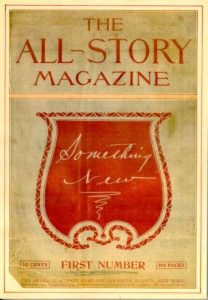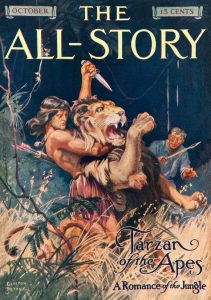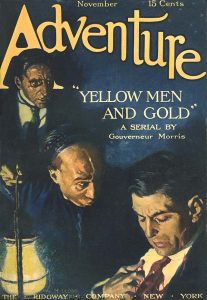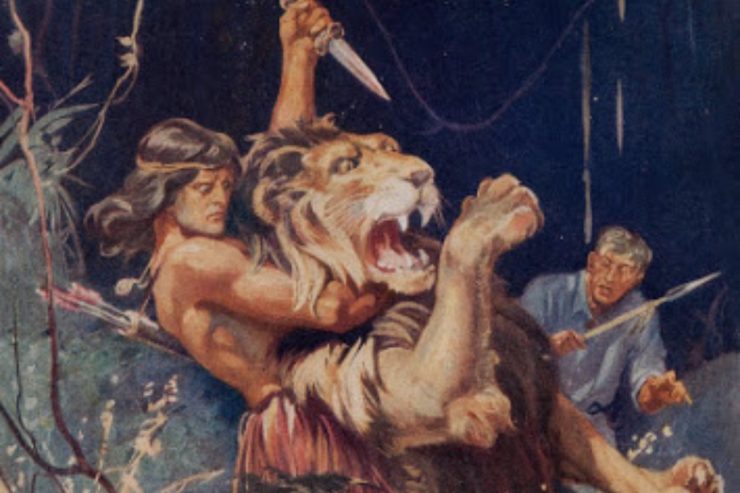 Shortly after The Argosy had been converted to the first all-fiction magazine in 1896, and not long thereafter the first pulp magazine, its circulation had doubled to about 80,000 copies per issue. By 1907, the year the periodical celebrated its 25th anniversary, its circulation had reached a half million copies, earning its publisher about $300,000 per year.
Shortly after The Argosy had been converted to the first all-fiction magazine in 1896, and not long thereafter the first pulp magazine, its circulation had doubled to about 80,000 copies per issue. By 1907, the year the periodical celebrated its 25th anniversary, its circulation had reached a half million copies, earning its publisher about $300,000 per year.
From its beginning, The Argosy made a home for fantastic fiction, reprinting “Citizen 504,” a dystopian short story written by Charles H. Palmer, in the December 1896 issue. Other reprints, from a variety of sources would follow. As the century turned, original fiction of a fantastic nature began to appear in The Argosy, including works by Jared L. Fuller, Park Winthrop, and longtime dime novelist William Wallace Cook. Edgar Franklin Stearns also began to contribute his humorous fantasies concerning off-beat contraptions to the magazine.
As its readership grew, The Argosy was bound to attract some imitators. Street & Smith, the longtime publisher of dime novels and story papers, was first to meet the call, debuting The Popular Magazine with its November 1903 issue. As the circulation of the new magazine grew, it became apparent to Frank Munsey that there was room on the newsstand for more than one pulp. At the end of 1904, the publisher debuted The All-Story Magazine.
 More than any other periodical prior to the introduction of the specialized science-fiction and fantasy pulps, The All-Story became the major repository for the “different” tale or the pseudo-scientific yarn. It was soon joined by other Munsey magazines–The Scrap Book and The Railroad Man’s Magazine (both 1906), The Ocean/The Live Wire (1907), and The Cavalier (1908). All of these, The Cavalier in particular, published fantastic fiction. However, it was all but a prelude to the serial novel that would begin in the February 1912 issue of The All-Story– “Under the Moons of Mars”–credited to Norman Bean.
More than any other periodical prior to the introduction of the specialized science-fiction and fantasy pulps, The All-Story became the major repository for the “different” tale or the pseudo-scientific yarn. It was soon joined by other Munsey magazines–The Scrap Book and The Railroad Man’s Magazine (both 1906), The Ocean/The Live Wire (1907), and The Cavalier (1908). All of these, The Cavalier in particular, published fantastic fiction. However, it was all but a prelude to the serial novel that would begin in the February 1912 issue of The All-Story– “Under the Moons of Mars”–credited to Norman Bean.
Bean’s novel—the first published fiction of Edgar Rice Burroughs—would introduce John Carter of Mars to readers. It would soon be followed by the author’s “Tarzan of the Apes,” published in its entirety in the October 1912 issue of The All-Story. These two novels, along with the pseudo-scientific works of H. G. Wells and his American disciple, George Allan England, would serve as templates for much of the science fiction written over the next twenty-five years, generating a type of fiction best known as “the scientific romance.” The Munsey chain in particular worked to develop this school of fiction, creating a stable of writers–Ray Cummings, J. U. Geisy, Victor Rousseau, Francis Stevens, Charles B. Stilson, and the best of all, Abraham Merritt–able to contribute such stories.
 Although the fiction of Burroughs and Wells and those “inspired” by their work would remain popular for some time to come, its share of the pulp market would diminish as new magazines began to arrive on the scene. Beginning with Adventure Magazine, introduced by the Ridgway Company in 1910, these specialized pulps lessened the attraction of the general fiction magazines for those who enjoyed a certain type of story–mystery, romance, western, or straight adventure. In not too many years, the fantasy and science-fiction fan would likewise be served.
Although the fiction of Burroughs and Wells and those “inspired” by their work would remain popular for some time to come, its share of the pulp market would diminish as new magazines began to arrive on the scene. Beginning with Adventure Magazine, introduced by the Ridgway Company in 1910, these specialized pulps lessened the attraction of the general fiction magazines for those who enjoyed a certain type of story–mystery, romance, western, or straight adventure. In not too many years, the fantasy and science-fiction fan would likewise be served.
To learn more about the images used in this post, click on the illustrations. Click here for references consulted for this article.






